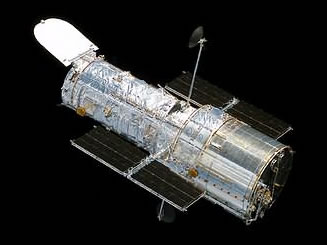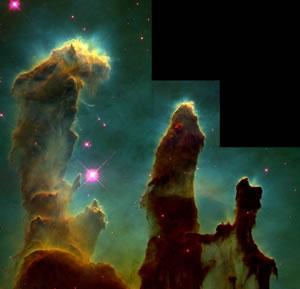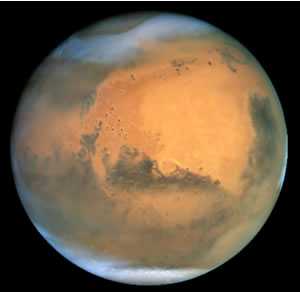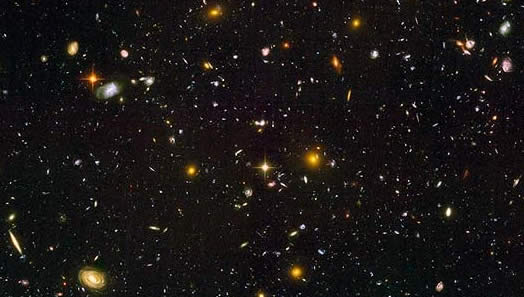 |
| Figure 1: The Hubble Space Telescope which orbits 600 km above Earth's surface. |
The past several months have marked a distinct change in priorities among the US government regarding science and space exploration. Last year, President Bush unveiled a new vision for NASA, requesting a shift in the agency's spending programmes to make travelling to the Moon and Mars the top priority. It is clear that President Bush was harkening back to the early 1960's, when space exploration was in its infancy and President Kennedy outlined a similar vision for putting a man on the Moon.
However, while the President's speech stressed the importance of
continuing a programme of human exploration that began in the 1960's, it was not revealed until later that many long standing NASA programmes are in serious jeopardy of being cut in order to pave the way for manned missions to the Moon and Mars. Most prominently was NASA Chief Administrator Sean O'Keefe's announcement only two days after the President that there would be no further maintenance missions to service the Hubble Space Telescope. Soon after, NASA further stated that the Hubble would be scuttled once it ceases to function properly. This unfortunate result of a combination of tight budgets and grandiose requests from the Bush Administration could be seen as a sign of the beginning of a bold type of space exploration, and the end of and era of discovery in which the Hubble played a central role.
 |
| Figure 2: The Eagle Nebula. On 1 April 1995, the Hubble took this famous photograph of pillar-like structures in the Eagle Nebula. These pillars are actually columns of interstellar hydrogen gas and dust that lead to star formation. |
Sky High
The concept of the Hubble Space Telescope dates back to 1962, when the US National Academy of Sciences recommended the building of a large space telescope. Development and construction of such a telescope dominated the 1970's and early 1980's, and the Hubble was finally launched in 1990. A 2.4-metre optical reflecting telescope that operates from ultra-violet to near infrared wavelengths, the Hubble orbits the earth 600 kilometres above the surface. Its design is simple and modular, which is essential in allowing new components to be added as the technology is developed. The Hubble has benefited from regular servicing every few years, as astronauts add new equipment or replace faulty instruments. Indeed, the launching of the Hubble yielded initial photographs that were out of focus, leading to the Hubble's first servicing mission to correct a misaligned mirror in 1993. Since this correction, the Hubble has been consistently relaying photographs of deep space that have aided researchers in studies of deep space, star formation, and black holes. For example, the 1995 images of the Eagle Nebula
(figure 2)are some of the most famous deep space images taken, and show where and how stars are born. In addition, the 1996 unveiling of 'deep field' images (figure 4) allows us to peer back in time 10 billion years, revealing 1,500 galaxies at various stages of development. In fact, only last year the Hubble recorded images of the furthest galaxies yet. Until the development of the Hubble Ultra Deep Field (HUDF) technology, these galaxies have been too faint to be seen. However, with this new deep field technology, the Hubble was able to peer back in time to 300 million years after the Big Bang, what is known by astronomers to be the 'Dark Ages' of the Universe, the early stages of galaxy formation.
It is images such as these that have periodically come from the Hubble that make this telescope so important in studying deep space. Nearly 2,700 papers have been published using information gleaned from the Hubble. Adam Riess, a supernova researcher for the Space Telescope Science Institute (STScI) in Baltimore, says that 'results [from HUDF technology] show that supernova in the early universe could be found if Hubble could be extended. Those could provide valuable insight into dark energy and the fate of the universe.'
Changing Priorities
However, extending the Hubble has recently become an impossibility, as its future servicing mission has been scrapped, and plans to scuttle the telescope once its batteries fail have been under development. It has also become clear that the decision to scuttle the Hubble is tied to a shift in focus from remote investigation to the more headline-grabbing vision of sending humans to the Moon and Mars, as President Bush outlined recently.
 |
| Figure 3: Mars. This image illustrates the amount of detail that can be generated from the Hubble telescope. It captures details only 16 km across, even though it is operating 68 million km from the planet. |
This vision can easily seem exciting, as bringing humans back into the fray of space exploration and discovery is reminiscent of the Apollo missions of the 1960's. Indeed, the President's Commission on the Moon, Mars, and Beyond proposes that crews carry out better science than probes, and that human habitation in space is feasible in the near future. Yet these conclusions are at best arguable, as it would surely be better and less expensive to position telescopes and probes in space away from human activity, in a much more controlled environment. In addition, unmanned missions can be prepared much more quickly and adapted to meet the needs of new research priorities, whilst manned missions take much more time to develop and execute, and are not as easily modified. For example, the successful Mars Rover missions have cost less than 1% that of the Apollo missions, and have given researchers incredible amounts of information regarding the surface of Mars.
Yet, it can be argued that government space programmes are not just about strict scientific research that yields significant results, or about putting together an economical mission. There is the element of inspiration, discovery, and national pride, which surely President Bush wanted to invoke by calling for manned missions to the Moon and Mars. But how do these changing priorities affect current space programmes like the Hubble?
No Wiggle Room
This shift in priorities of the US Space Programme has yielded several casualties, such as the Hubble Space Telescope as mentioned above. This will allow the transfer of funds originally reserved for the Hubble to be used in developing the manned missions to the Moon and Mars. Funds will also be squeezed from other areas, including the current research programme examining the earth's environment, which will be cut by $1.1 billion by 2009.
Due to the White House's budget request, there has been no wiggle room left for extra funds to save the Hubble, despite many protests by scientists and policymakers in Congress. Holland Ford, a Johns Hopkins University astronomer who helped build the newest camera on the Hubble was surprised by this announcement. 'It means a lot of excellent science that could be done will not be done. It will be a great loss for science. It will also be a great loss for the way in which Hubble communicates science through images to people all around the world.' Indeed, this decision is not final, as budgetary approval rests with Congress, and though the Hubble does have support among several members of Congress, it is unclear whether it will be enough to save the Hubble from its fate, as a new era of space exploration is ushered into prominence.
 |
| Figure 4: Hubble Ultra Deep Field. Recently, astronomers using the Hubble unveiled the deepest look into the universe yet, showing what could be the most distant and the youngest galaxies ever seen. |









Comments
Add a comment